This article needs additional citations for verification. (September 2010) |
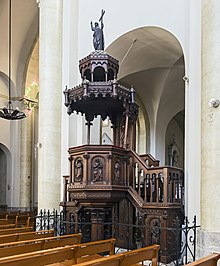
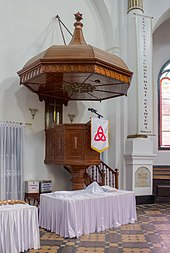
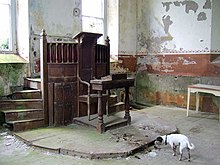
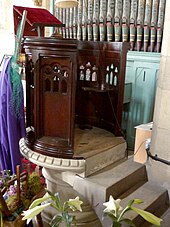
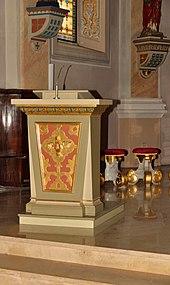

A pulpit is a raised stand for preachers in a Christian church. The origin of the word is the Latin pulpitum (platform or staging).[1] The traditional pulpit is raised well above the surrounding floor for audibility and visibility, accessed by steps, with sides coming to about waist height. From the late medieval period onwards, pulpits have often had a canopy known as the sounding board, tester or abat-voix above and sometimes also behind the speaker, normally in wood.[2] Though sometimes highly decorated, this is not purely decorative, but can have a useful acoustic effect in projecting the preacher's voice to the congregation below, especially prior to the invention of modern audio equipment. Most pulpits have one or more book-stands for the preacher to rest his bible, notes or texts upon.
The pulpit is generally reserved for clergy. This is mandated in the regulations of the Catholic Church, and several others (though not always strictly observed). Even in Welsh Nonconformism, this was felt appropriate, and in some chapels a second pulpit was built opposite the main one for lay exhortations, testimonies and other speeches.[3] Many churches have a second, smaller stand called the lectern located in the Epistle side, which can be used by lay persons, and is often used for other Scripture lessons and ordinary announcements. The traditional Catholic location of the pulpit to the left side of the chancel or nave has been generally retained by Lutherans and many Anglicans,[4] while in Presbyterian and Baptist churches the pulpit is located in the centre behind the communion table.[5] Many modern Roman Catholic churches have an ambo that functions as both a pulpit and lectern.[6]
Equivalent platforms for speakers are the bema (bima, bimah) of ancient Greece and Jewish synagogues, and the minbar of Islamic mosques. From the pulpit is often used synecdochically for something which is said with official church authority.
- ^ "Pulpit". Merriam-Wester Online Dictionary. Retrieved 13 February 2015.
- ^ Illustrated Dictionary of British Churches
- ^ Francis, 19
- ^ "Acolyte Handbook" (PDF). Cross of Christ Lutheran Church. 2016. Retrieved 30 November 2021.
When facing the altar, the left side is called the Gospel side. The right side is called the Epistle side. In the early church, the lector (reader) read the Gospel from the left side of the altar and the Epistle from the right side.
- ^ Donelson, Paul G.; Hickman, Hoyt (1984). "The Key Furnishings in the Chancel". UMCS. Retrieved 30 November 2021.
- ^ Daley, Michael J. (2009). Our Catholic Symbols: A Rich Spiritual Heritage. Twenty-Third Publications. p. 23. ISBN 978-1-58595-753-8.